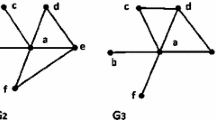Abstract
Models of social dynamics grew up from methods used on the physical and life sciences. Different types of growth processes, among others those which lead to finite time singularities are reviewed. The scope and limits of the analogy between neurological disorders (such as epilepsy) and financial crises are analyzed by exploiting the concept of dynamical diseases. Governing rules of social dynamics phenomena can be extracted from collected empirical data, and they have some predictive power. Data for evolving patent citation networks, and annual budget changes are analyzed for generating dynamical models.
Similar content being viewed by others
References
Albeverio, S., V. Jentsch and H. Kantz (eds) (2006) Extreme Events in Nature and Society, Springer, Berlin/Heidelberg/New York.
Aradi, I. and P. Érdi (2006) “Computational neuropharmacology: dynamical approaches in drug discovery,” Trends in Pharmacological Sciences 27: 240–243.
Aruka, Y. (2007) “The Evolution of Moral Science: Economic Rationality in the Complex Social System,” Evolutionary and Institutional Economics Review 4: 217–237.
Belair, J., L. Glass, U. An der Heiden and J. Milton (1995) “Dynamical disease: Identification, temporal aspects and treatment strategies of human illness,” Chaos 5: 1–7.
Ben-Ari, Y., V. Crepel and A. Represa (2008) “Seizures beget seizures in temporal lobe epilepsies: the boomerang effects of newly formed aberrant kainatergic synapses,” Epilepsy Curr 3: 68–72.
Buckmaster, P. S. and K. Thind (2005) “Quantifying routes of positive-feedback among granule cells in a model of temporal lobe epilepsy,” Epilepsia, 46: 91–131.
Csárdi, G., K. J. Strandburg, L. Zalányi, J. Tobochnik and P. Erdi (2007) “Modeling innovation by a kinetic description of the patent citation system,” Physica A: Statistical and Theoretical Physics 374: 1-2, 783–793.
Csárdi, G., K. J. Strandburg, J. Tobochnik and P. Erdi (2009) “The inverse problem of evolving networks—with application to social nets,” in B. Bollobás, R. Kozma and D. F. Miklós (eds) Handbook of Large-Scale Random Networks, Springer-Verlag.
Einstein, A. (1927) Isasc Newton. Smithonian Annual Report.
Erdi, P. (2007) Complexity Explained. Springer Verlag, Berlin-Heidelberg.
Fergusson, N. (2009) http://www.nybooks.com/articles/22756
Gowers, W. R. (1881) Epilepsy and Other Chronic Convulsive Disorders: Their Causes, Symptoms and Treatment. London: J&A Churchill.
Ionov, D. (2009) “Self-reinforcing loop mechanism in epilepsy,” Medical Hypotheses 73: 608–609.
Jones, B. D. (2001) Politics and the Architecture of Choice. University of Chicago Press.
Jones, B. D. and F. R. Baumgartner (2005) The Politics of Attention: How Government Prioritizes Problems University of Chicago Press.
Jones, B. D., L. Zalányi, F. Baumgartner and P. Erdi (2009) “Dynamic Threshold Modeling of Budget Changes,” Proceedings of AAAI Fall Symposium; Complex Adaptive Systems and the Threshold Effect: Views from the Natural and Social Sciences, AAA Press, pp. 61–66.
Helbing, D. (1995) Quantitative Sociodynamics. Stochastic Methods and Models of Social Interaction Processes, Kluwer Academic, Dordrecht.
Li, X., G. Ouyang, X. Yao and X. Guan (2004) “Dynamical characteristics of pre-epileptic seizures in rats with recurrence quantification analysis,” Physics Letters A 333: 164–171.
Liu, D., Z. Pang and Z. Wang (2009) “Epileptic seizure prediction by a system of particle filter associated with a neural network,” EURASIP Journal on Advances in Signal Processing.
Mainzer, K. (2009) “Challenges of Complexity in the 21st Century,” Evolutionary and Institutional Economics Review 6: 1–22.
Montroll, E. W. (1978) “Social Dynamics and the Quantifying Forces,” Proceedings of National Academy Science USA 75: 4633–4636.
Padgett, J. F. (1980) “Bounded rationality in budgetary research,” American Political Science Review 74: 354–372.
Palla, G., A.-L. Barabási and T. Vicsek (2007) “Quantifying social group evolution,” Nature 446: 7136, 664–667.
Rigo, J.-M., G. Hans et al. (2002) “The anti-epileptic drug levetiracetam reverses the inhibition by negative allosteric modulators of neuronal GABA- and glycine-gated currents,” British Journal of Pharmacology 36: 659–672.
Rosser, J. B., Jr. (2006) “Complex dynamics and post Keynesian economics,” in M. Setterfield (ed) Complexity, Endogenous Money and Macroeconomic Theory: Essays in Honour of Basil J. Moore, Edward Elgar, Cheltenham.
Sutala, T. (2004) “Mechanisms of epilepsy progression: current theories and perspectives from neuroplasticity in adulthood and development,” Epilepsy Research 60: 161–171.
Soltesz, I. and K. Staley (2008) Computational Neuroscience in Epilepsy, Elsevier.
Sornette, D. (2002) “Predictability of catastrophic events: Material rupture, earthquakes, turbulence, financial crashes, and human birth,” Proceedings of National Academy of Sciences USA.
Sornette, D. (2003) Why Stock Markets Crash: Critical Events in Complex Financial Systems, Princetion University Press.
Sperling, W., S. Bleich and U. Reulbach (2008) “Black Monday on stock markets throughout the world—A new phenomenon of collective panic disorder? A psychiatric approach,” Medical Hypotheses 71.6: 972–974.
Sperling, W., T. Biermann and J. Maler (2009) “Global panic reaction—A therapeutic approach to a world-wide economic crisis,” Medical Hypotheses 73.2: 167–168.
Taleb, N. (2005) Mandelbrot Makes Sense: A Book Review Essay. http://www.fooledbyrandomness.com/mandelbrotandhudson.pdf (March 15th, 2010)
Soros, G. (1988) The Alchemy of Finance: Reading the mind of the market, Simon and Schuster.
Weidlich, W. (2002) Sociodynamics: A Systematic Approach to Mathematical Modelling in the Social Sciences.
Weidlich, W. (2006) “Intentions and Principles of Sociodynamics,” Evolutionary and Institutional Economics Review 2: 161–165.
Wiener, N. (1948) Cybernetics: Or Control and Communication in the Animal and the Machine, MIT Press. Cambridge.
Author information
Authors and Affiliations
Corresponding author
About this article
Cite this article
Érdi, P. Scope and Limits of Predictions by Social Dynamic Models: Crisis, Innovation, Decision Making. Evolut Inst Econ Rev 7, 21–42 (2010). https://doi.org/10.14441/eier.7.21
Published:
Issue Date:
DOI: https://doi.org/10.14441/eier.7.21
Keywords
- social dynamics
- feedback
- causality
- predictability
- financial crisis
- patent citations
- innovation
- budget changes
- power law distribution



